As a personal witness who has been working in the field of digital currencies for ten years, I firmly believe that I have a unique insight in this regard. Ten years ago, I dismissed those obscure technical terms, thinking that they were just boring talks, and I scoffed at those so-called technical analyses, believing that my intuition was the most reliable. In those three years of arbitrary behavior, I blindly invested, but in the end I gained nothing.
Fortunately, I received generous help from my master, who lent me 400,000 yuan, allowing me to restart my investment journey. To fully dedicate myself to the digital currency field, I even resolutely resigned from my high-paying job and became a full-time coin trader. Today, my assets in the market have reached 50 million, and I can easily earn 50,000 yuan a day just from interest income.

In addition to solid technical skills, I have always adhered to the following eight strict investment strategies and principles:
1. Make up for the lost position to break even, and extravagant profits are greedy.
When speculating in coins, there are always a few coins that are stuck. At this time, remember not to expect to turn losses into profits. Being eager for quick success will only make you sink deeper and deeper. Honestly make up for the lost position, keep the principal, and you can have a long-term income.
2. A wave of high on a calm surface, beware of big waves behind.
The coin market appears calm on the surface, but undercurrents are surging. Do not be deceived by the small gains in front of you, stay vigilant, and beware of the big shocks that will follow.
3. A big rise is always followed by a pullback, and K-lines form a triangle over several days.
When the coin price soars, don't be overjoyed. Because after that, there will inevitably be a callback. Look at the K-line, isn't it just an equilateral triangle outlined over several days?
4. Buy when it's falling, not when it's rising, sell when it's rising, not when it's falling. Going against the market is the mark of a hero.
Buy coins when the price is falling gradually, and sell coins when the price is rising positively. Going against the grain can lead to unexpected success.
5. Don't sell when it's spiking, don't buy when it's diving, don't trade when it's sideways.
Don't rush to sell when the coin price spikes, and don't rush to buy the dip when it's diving. When it's sideways, control your hands even more and wait and see.
6. Look at support levels in an upward trend and resistance levels in a downward trend.
When the coin price rises, pay attention to the support level to prevent a pullback. When the coin price falls, pay attention to the resistance level for buying opportunities.
7. Full position operation is a big taboo, don't be stubborn, know when to stop in the face of impermanence, and be free to enter and exit at the right time.
Never operate with a full position and bet everything. The coin market is impermanent, so you must know when to take profits and be free to enter and exit. Observe the changes and seize the best opportunity.
8. Speculating in coins is about mentality, greed and fear are great harms.
Be cautious when chasing rises and falls, and be calm and comfortable. Mentality is very important when speculating in coins. Greed and fear are our biggest enemies. Avoid chasing rises and killing falls, and maintain a peaceful mentality.
So how to do a good job in speculating in coins? Once a person enters the financial market, it is difficult to turn back. If you are still confused about your losses now and plan to treat speculating in coins as a second career in the future, you must know the 'triangle warfare'. Reading and understanding it thoroughly will definitely help you avoid many detours. They are all personal experiences and feelings. It is recommended to save it and ponder it repeatedly!
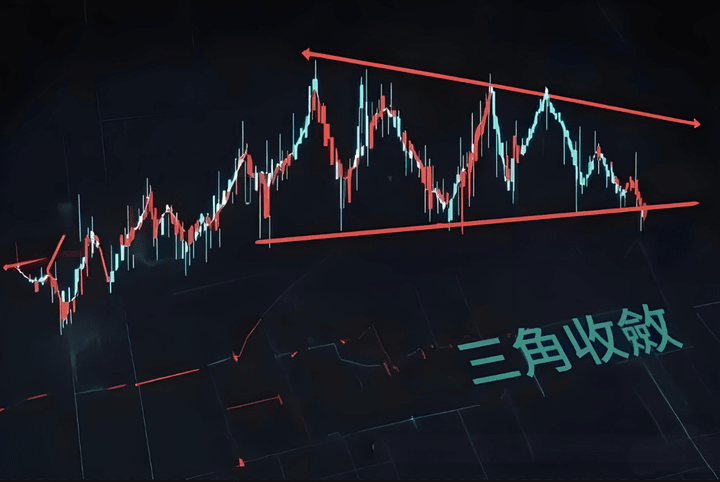
Triangle convergence, also known as converging triangle, is a common consolidation pattern. It can be further divided into three types: symmetrical triangle, ascending triangle, and descending triangle. In the following chapters, we will teach these three types in detail.
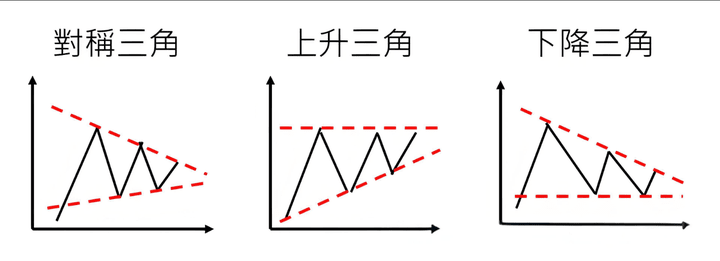
Symmetrical Triangle
A symmetrical triangle refers to a triangle whose sides converge from left to right. It is also the triangle convergence pattern in the general sense. A symmetrical triangle may appear in an upward trend or a downward trend.
When a symmetrical triangle appears in a downward trend, it usually continues the previous downward trend after breaking through the lower side of the triangle. The figure below is an example. In the figure, we use A, B, C, D, and E to mark the highs and lows on both sides of this triangle convergence. The highs on its upper side are constantly lowering, and the lows on its lower side are constantly rising. This is a typical feature of a symmetrical triangle.
As you can see from the figure below, after the price experienced point F, it finally broke below the bottom of the triangle, thus continuing the previous downward trend.
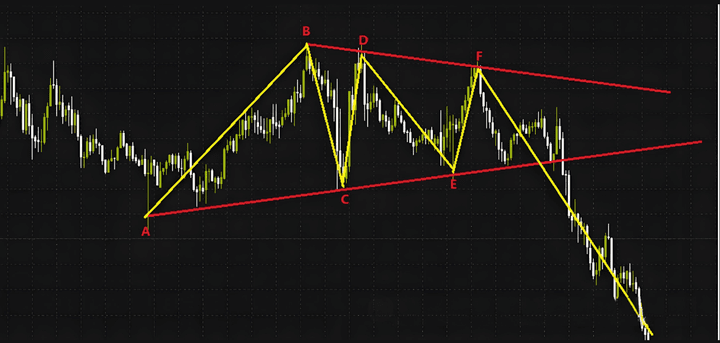
When a symmetrical triangle appears in an upward trend, it usually continues the previous upward trend after breaking through the upper side of the triangle.
Ascending Triangle
Ascending triangles usually appear in upward trends. Its upper side is a horizontal resistance line, and its lower side is an upward-sloping support line.
Below is an example of an ascending triangle, where two points are particularly noteworthy:
Point E did not touch the upper side of the ascending triangle, which does not affect that this is a valid triangle convergence pattern. In reality, one or even more highs or lows of many triangles are not on the upper or lower side of the triangle;
After the price breaks upward through the upper side of the ascending triangle, it may fall back to the upper side and find support. This is similar to the neckline retracement of a double bottom pattern and is also an entry opportunity.
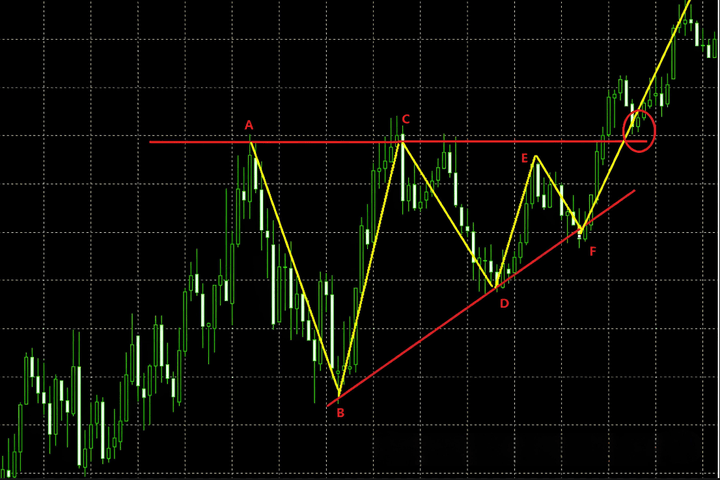
Descending Triangle
Descending triangles usually appear in downward trends. Its lower side is a horizontal support line, and its upper side is a downward-sloping resistance line.
The following is an example of a descending triangle. As mentioned earlier, the highs and lows of many converging triangles do not necessarily touch the upper or lower sides of the triangle. In this example, point F did not touch the upper resistance line of the triangle and turned downward, eventually breaking through the lower support line.
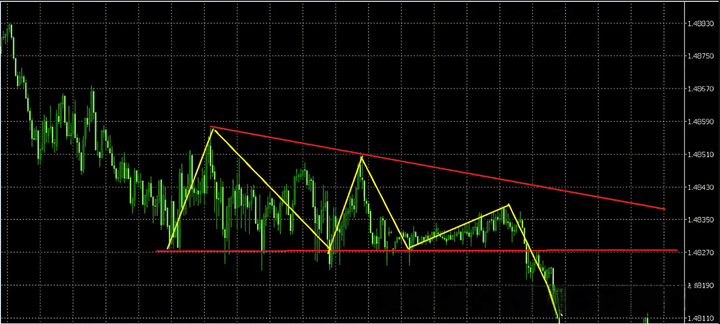
Application of Triangle Convergence Pattern
Converging triangles provide traders with entry and exit opportunities:
After identifying the upper side of the triangle, when the market price touches the upper side and falls back, it is an opportunity to sell;
After identifying the lower side of the triangle, when the market price touches the lower side and rebounds, it is an opportunity to buy;
When the market price breaks upward through the upper side of the triangle, it is an opportunity to follow and follow up;
When the market price breaks downward through the lower side of the triangle, it is an opportunity to follow and sell.
Fundamentally, the theory of triangles is the theory of support and resistance lines, but it needs to be applied more flexibly.

Breakout direction of triangle convergence
Converging triangles are usually regarded as consolidation patterns. After breaking through the upper or lower side of the triangle, they will continue the previous major trend. But this is not absolute. Sometimes triangle convergence can also become bottom or top patterns.
Below is an example of a symmetrical triangle that appears in a downward trend. Although the price was blocked and fell after touching point F, it was supported by the bottom of the triangle and rose again, breaking through the top of the triangle and finally forming a large increase. In this type of triangle pattern, we can still apply the triangle theory, just follow the price breakthrough and buy or sell.
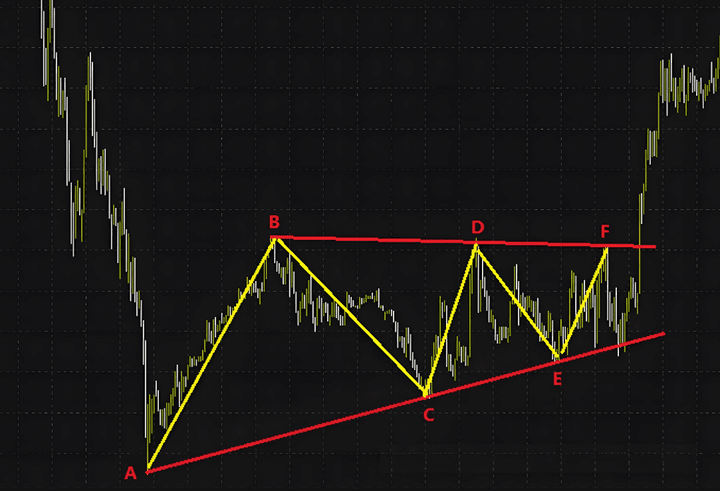
Failed Triangle Convergence Pattern
Not all triangle convergences will eventually become valid patterns, and failure is also common. In the case in the figure below, the trend of the K-line between the two red lines is almost a standard symmetrical triangle, but the price finally broke below the bottom of the triangle, and this adjustment pattern eventually evolved into an N-shaped adjustment.
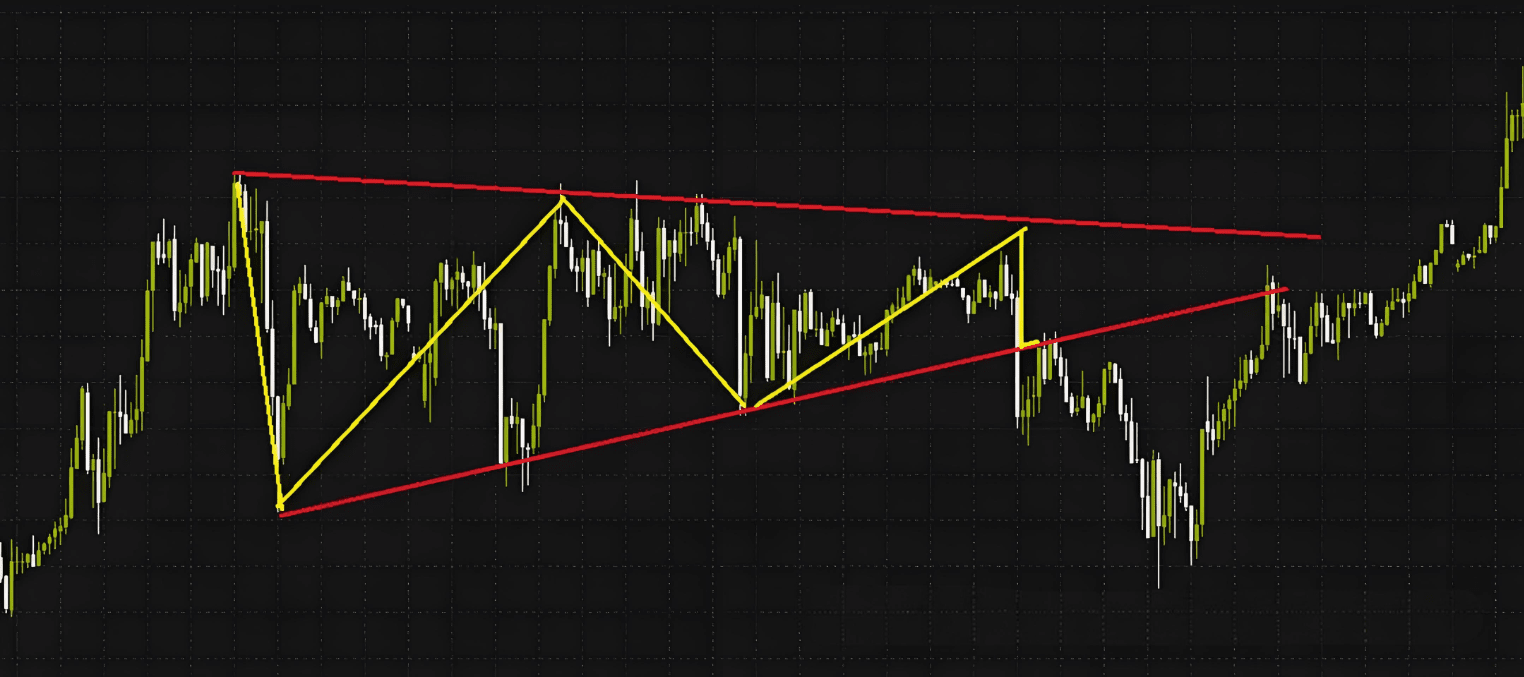
The above are the techniques and tactics of triangle convergence! I hope it will be helpful to everyone and easy to understand!
Finally, I will share a set of stable and profitable methods in the crypto world!
1. Coin Hoarding Method: Applicable to bull and bear markets.
Coin hoarding is the simplest but also the most difficult strategy. The simplest part is that you only need to buy certain coins and then hold them for half a year or more without any operation. Usually, the minimum return can reach ten times. However, novices often want to change coins or sell them because they see high returns or big drops in the price of coins. Many people find it difficult to persist for a month without operating, let alone a year. This is also why this is the most difficult part. #中国投资者涌向印尼
2. Bull Market Chase the Dip Method: Only applicable to bull markets.
Use no more than one-fifth of your total funds as idle money. This strategy is suitable for coins ranked between 20 and 100 in market capitalization, because at least you won't be stuck for a long time. For example, if you buy an altcoin, wait for it to rise by 50% or more, then you can switch to another coin that has plummeted, and so on. If your first altcoin is stuck, then continue to wait, the bull market will definitely get you out. But the premise is that the selected coin cannot be too bad. This strategy is actually not easy to control. In a bull market, almost all coins will rise, and funds are like a huge hourglass, slowly penetrating into each coin, starting with the big coins. #ETH质押退出动态观察
3. Pyramid Bottom Fishing Method: Suitable for foreseeable major crashes. Bottom fishing method: Entrust to buy at 80%, 70%, 60%, and 50% of the coin price respectively, according to the position ratio of one-tenth, two-tenths, three-tenths, and four-tenths.
4. Moving Average Method: Requires some basic knowledge of K-lines. Set the indicator parameters MA5, MA10, MA20,
MA30, MA60, select the daily chart level. If the current price is higher than the MA5 and MA10 lines, hold steady. If MA5 breaks below MA10, sell the coin; if MA5 breaks through MA10, buy and establish a position.
5. Violent Coin Hording Method: Suitable for long-term quality coins that you are familiar with. If you have a sum of liquid funds, for example, a certain coin is currently priced at $8, buy it at a price of $7. After the purchase is successful, sell it at a price of $8.8. The profit is used to hoard coins. Liquid funds are used to wait for the next opportunity. Adjust dynamically according to the current price. If there are three such opportunities in a month, you can hoard a lot of coins. The formula is: the position building price is equal to 90% of the current price, and the selling price is equal to 110% of the current price. Unless the increase reaches 3-5 times, do not sell it. I believe you should gain something after reading it. #BitDigital转型
The above are all trading experiences from 10 years of speculating in coins. I have experienced a lot of bumps and bruises. These are heartfelt words of great enlightenment. I hope they will be useful to everyone. Yan An's products must be excellent. There is a beautiful woman in the crypto world, unparalleled and independent. Her soul has the Tao, and she has the skills to control coins!
Even the most diligent fisherman will not go out to sea in the stormy season, but carefully guard his boat. This season will always pass, and a sunny day will always come! Follow me, I will give you fish and also the ability to fish. The door to the crypto world is always open. Following the trend is the only way to have a smooth life. Save this and keep it in mind!